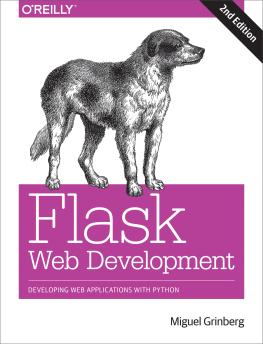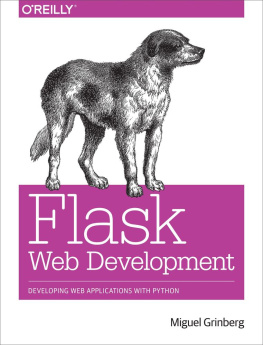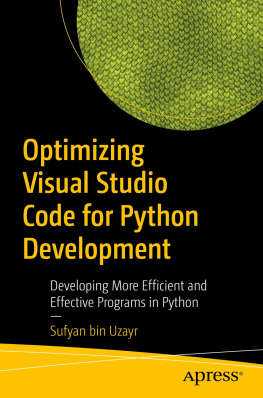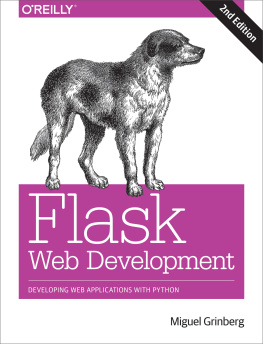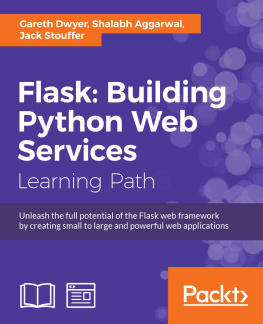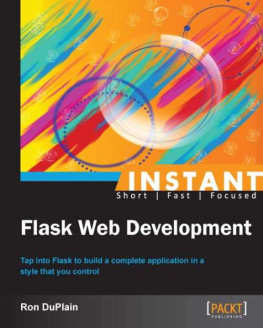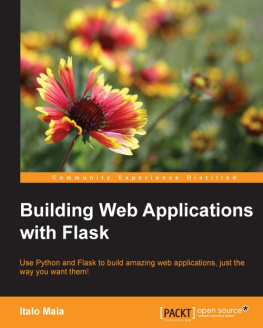Miguel Grinberg - Flask Web Development: Developing Web Applications with Python
Here you can read online Miguel Grinberg - Flask Web Development: Developing Web Applications with Python full text of the book (entire story) in english for free. Download pdf and epub, get meaning, cover and reviews about this ebook. year: 2018, publisher: O’Reilly Media, genre: Computer. Description of the work, (preface) as well as reviews are available. Best literature library LitArk.com created for fans of good reading and offers a wide selection of genres:
Romance novel
Science fiction
Adventure
Detective
Science
History
Home and family
Prose
Art
Politics
Computer
Non-fiction
Religion
Business
Children
Humor
Choose a favorite category and find really read worthwhile books. Enjoy immersion in the world of imagination, feel the emotions of the characters or learn something new for yourself, make an fascinating discovery.
- Book:Flask Web Development: Developing Web Applications with Python
- Author:
- Publisher:O’Reilly Media
- Genre:
- Year:2018
- Rating:4 / 5
- Favourites:Add to favourites
- Your mark:
- 80
- 1
- 2
- 3
- 4
- 5
Flask Web Development: Developing Web Applications with Python: summary, description and annotation
We offer to read an annotation, description, summary or preface (depends on what the author of the book "Flask Web Development: Developing Web Applications with Python" wrote himself). If you haven't found the necessary information about the book — write in the comments, we will try to find it.
Flask Web Development: Developing Web Applications with Python — read online for free the complete book (whole text) full work
Below is the text of the book, divided by pages. System saving the place of the last page read, allows you to conveniently read the book "Flask Web Development: Developing Web Applications with Python" online for free, without having to search again every time where you left off. Put a bookmark, and you can go to the page where you finished reading at any time.
Font size:
Interval:
Bookmark:
by Miguel Grinberg
Copyright 2018 Miguel Grinberg. All rights reserved.
Printed in the United States of America.
Published by OReilly Media, Inc. , 1005 Gravenstein Highway North, Sebastopol, CA 95472.
OReilly books may be purchased for educational, business, or sales promotional use. Online editions are also available for most titles (http://oreilly.com/safari). For more information, contact our corporate/institutional sales department: 800-998-9938 or corporate@oreilly.com .
- Editor: Allyson MacDonald
- Production Editor: Colleen Cole
- Copyeditor: Dwight Ramsey
- Proofreader: Rachel Head
- Indexer: Ellen Troutman
- Interior Designer: David Futato
- Cover Designer: Randy Comer
- Illustrator: Rebecca Demarest
- March 2018: Second Edition
- 2018-03-02: First Release
See http://oreilly.com/catalog/errata.csp?isbn=9781491991732 for release details.
The OReilly logo is a registered trademark of OReilly Media, Inc. Flask Web Development, the cover image, and related trade dress are trademarks of OReilly Media, Inc.
While the publisher and the author have used good faith efforts to ensure that the information and instructions contained in this work are accurate, the publisher and the author disclaim all responsibility for errors or omissions, including without limitation responsibility for damages resulting from the use of or reliance on this work. Use of the information and instructions contained in this work is at your own risk. If any code samples or other technology this work contains or describes is subject to open source licenses or the intellectual property rights of others, it is your responsibility to ensure that your use thereof complies with such licenses and/or rights.
978-1-491-99173-2
[LSI]
For Alicia.
Flask stands out from other frameworks because it lets developers take the drivers seat and have full creative control of their applications. Maybe you have heard the phrase fighting the framework before. This happens with most frameworks when you decide to solve a problem with a solution that isnt the official one. It could be that you want to use a different database engine, or maybe a different method of authenticating users. Deviating from the path set by the frameworks developers will give you lots of headaches.
Flask is not like that. Do you like relational databases? Great. Flask supports them all. Maybe you prefer a NoSQL database? No problem at all. Flask works with them too. Want to use your own homegrown database engine? Dont need a database at all? Still fine. With Flask you can choose the components of your application, or even write your own if thats what you want. No questions asked!
The key to this freedom is that Flask was designed from the start to be extended. It comes with a robust core that includes the basic functionality that all web applications need and expects the rest to be provided by some of the many third-party extensions in the ecosystemand, of course, by you.
In this book I present my workflow for developing web applications with Flask. I dont claim this to be the only true way to build applications with this framework. You should take my choices as recommendations and not as gospel.
Most software development books provide small and focused code examples that demonstrate the different features of the target technology in isolation, leaving the glue code that is necessary to transform these different features into a fully working application to be figured out by the reader. I take a completely different approach. All the examples I present are part of a single application that starts out very simple and is expanded in each successive chapter. This application begins life with just a few lines of code and ends as a nicely featured blogging and social networking application.
You should have some level of Python coding experience to make the most of this book. Although the book assumes no previous Flask knowledge, Python concepts such as packages, modules, functions, decorators, and object-oriented programming are assumed to be well understood. Some familiarity with exceptions and diagnosing issues from stack traces will be very useful.
While working through the examples in this book, you will spend a great deal of time in the command line. You should feel comfortable using the command line of your operating system.
Modern web applications cannot avoid the use of HTML, CSS, and JavaScript. The example application that is developed throughout the book obviously makes use of these, but the book itself does not go into a lot of detail regarding these technologies and how they are used. Some degree of familiarity with these languages is recommended if you intend to develop complete applications without the help of a developer versed in client-side techniques.
I released the companion application to this book as open source on GitHub. Although GitHub makes it possible to download applications as regular ZIP or TAR files, I strongly recommend that you install a Git client and familiarize yourself with source code version control (at least with the basic commands to clone and check out the different versions of the application directly from the repository). The short list of commands that youll need is shown in . You will want to use version control for your own projects as well, so use this book as an excuse to learn Git!
Finally, this book is not a complete and exhaustive reference on the Flask framework. Most features are covered, but you should complement this book with the official Flask documentation.
This book is divided into three parts.
, explores the basics of web application development with the Flask framework and some of its extensions:
describes the installation and setup of the Flask framework.
dives straight into Flask with a basic application.
introduces the use of templates in Flask applications.
introduces web forms.
introduces databases.
introduces email support.
presents an application structure that is appropriate for medium and large applications.
, builds Flasky, the open source blogging and social networking application that I developed for this book:
implements a user authentication system.
implements user roles and permissions.
implements user profile pages.
creates the blogging interface.
implements followers.
implements user comments for blog posts.
implements an application programming interface (API).
, describes some important tasks not directly related to application coding that need to be considered before publishing an application:
describes different unit testing strategies in detail.
gives an overview of performance analysis techniques.
describes deployment options for Flask applications, including traditional, cloud-based, and container-based solutions.
lists additional resources.
The code examples presented in this book are available for download at https://github.com/miguelgrinberg/flasky.
The commit history in this repository was carefully created to match the order in which concepts are presented in the book. The recommended way to work with the code is to check out the commits starting from the oldest, then move forward through the commit list as you make progress with the book. As an alternative, GitHub will also let you download each commit as a ZIP or TAR file.
Font size:
Interval:
Bookmark:
Similar books «Flask Web Development: Developing Web Applications with Python»
Look at similar books to Flask Web Development: Developing Web Applications with Python. We have selected literature similar in name and meaning in the hope of providing readers with more options to find new, interesting, not yet read works.
Discussion, reviews of the book Flask Web Development: Developing Web Applications with Python and just readers' own opinions. Leave your comments, write what you think about the work, its meaning or the main characters. Specify what exactly you liked and what you didn't like, and why you think so.

